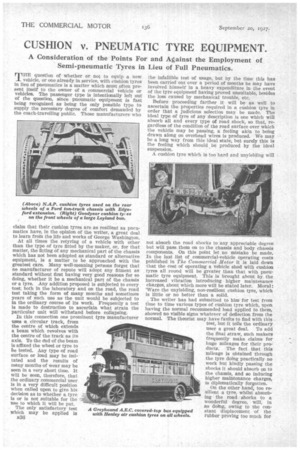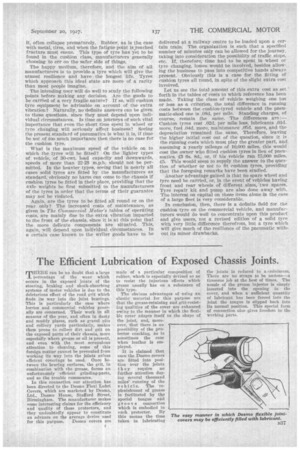CUSHION v. PNEUMATIC TYRE EQUIPMENT.
Page 54

Page 55

If you've noticed an error in this article please click here to report it so we can fix it.
A Consideration of the Points For and Against the Employment of Semi-pneumatic Tyres in Lieu of Full Pneumatics.
TTIE question of whether or not to equip a new vehicle, or one already in service, with cushion tyres in lieu of pneumatics is a matter which must often present itself to the owner of a commercial Vehicle or vehicles. The passenger type is intentionally left out of the question, since pneumatic equipment is fast being recognized as being the only possible type to supply the necessary degree of comfort demanded by the coach-travelling public. Those manufacturers who
claim that their cushion tyres are as resilient as pneumatics have, in the opinion of the writer, a great deal to learn froth the life and works of George Washington.
At all times the retyring of a vehicle with other than the type of tyre fitted by the maker, or, for that matter, the fitting of any mechanical part of the chassis which has not been adopted as standard or alternative equipment, is a matter to be approached with the greatest care. Many well-meaning persons forget that no manufacturer of repute will adopt any fitment as standard without finst having very good reasons for so doing, whether it be a mechanical part of the chassis or a tyre. Any addition proposed is subjected to every test, both in the laboratory and on the road, the road test taking the form of many months and sometimes years of such use as the unit would be subjected to in the ordinary course of its work. Frequently a test is made to destruction to ascerfain what strain the particular unit will withstand before collapsing.
The only satisfactory test which may be applied is B36 the infallible test of usage, but by the time this has been carried out over a period of months he may have involved himself in a heavy expenditure in the event of the tyre equipment having proved unsuitable, besides the loss caused by mechanical trouble, etc.
Before proceeding farther it will be as well to ascertain the properties required in a cushion tyre in order that a judicious selection may be made. The ideal type of tyre of any description is one which will absorb all and every type of road shock, so that, regardless of the condition of the road surface over which the vehicle may be passing, a feeling akin to being drawn along on overhead wires is produced. We may be a long way from this ideal state, but surely this is the feeling which should be produced by the ideal suspension.
A cushion tyre which is too hard and unyielding will
not absorb the road shocks to any appreciable degree but will pass them on to the chassis and body chassis components. On this point let no mistake be made. In the last list of commercial-vehicle operating costs published in The Commercial Motor it is laid down that the cost of operating a vehicle shod with cushion tyres all round will be greater than that with pneumatic tyre equipment. This is brought about by the increased vibration introducing higher maintenance charges, about which more will be stated later. Moral: 'Ware the unyielding, non-resilient cushion tyre, which is little or no better than a solid.
The writer has had submitted to him for test from time to time various types of cushion tyre which, upon having the normal recommended load applied to them, showed no visible signs whatever of deflection from the normal. The theorist may have faults to find with this test, but it tells the ordinary user a great deal. To add the final straw, such makers frequently make claims for huge mileages for their products. The fact that this mileage is obtained through the tyre doing practically no work but kindly passing the shocks it should absorb on to the chassis, and so inducing higher maintenance charges, as diplomatically forgotten.
On the other band, too resilient a tyre, whilst absorbing the roadshocks to a wonderful degree, will, in so doing, owing to the constant displacement of the rubber proving too much for It, often collapse prematurely. Rubber, as is the case with metal, tires, and when the fatigue point is reached fracture must ensue. This type of tyre has yet to be found in the cushion class, manufacturers generally choosing to err on the safer side of things.
The happy medium, therefore, and the aim of all manufacturers is to provide a tyre which will give the utmost resilience and have the longest life. Tyres which approach this ideal state are more of a rarity than most people imagine.
The intending user will do well to study the following points before making any decision. Are the goods to be carried of a very fragile nature? If so, will cushion tyre equipment be advisable on account of the extra vibration? Naturally, no definite answers can he given to these questions, since they must depend upon individual circumstances. Is time on journeys of such vital importance that even the short time spent in wheel or tyre changing will seriously affect business? Seeing the present standard of pneumatics is what it is, if time be not of too much importance then there is no case for the cushion tyre.
What is the maximum speed of the vehicle on to which the tyres will be fitted? On the lighter types of vehicle, of 30-cwt. load capacity and downwards, speeds of more than 22-23 m.p.h. should not be permitted. In the heavier types, seeing that in nearly all cases solid tyres are fitted by the Manufacturers as standard, obviously no harm can come to the chassis if cushion tyres be fitted in their place, providing that the axle weights be first submitted to the manufacturers of the tyres in order that the terms of their guarantee may not be violated.
Again, are the tyres to be fitted all round or on the• rear only? The increased costs of maintenance, as given in The Commercial Motor's tables of operating costs, are mainly due to the extra vibration imparted to the front of the chassis, since it is at this point that the more delicate components are situated. This, again, will depend upon individual circumstances. In a certain case known to the writer goods have to be
delivered at a railway centre to be loaded upon a certain train. The organization is such that a specified number of minutes only can be allowed for the journey, taking into consideration the possibility of traffic stops, etc. If, therefore, time had to be spent in wheel or tyre changing, losses would be involved, besides allowing the business to pass into competitive hands always present. Obviously this is a case for the fitting of cushion tyres all round, in spite of the slight extra cost involved.
Let us see the total amount of this extra cost as set forth in the tables of Costs to which reference has been made. Taking the class of vehicle weighing one ton or less as a criterion, the total difference in running costs between the cushion-tyred vehicle and the pneumatic-shod one is .08th per mile. Standing charges, of course, remain the same. The differences are:— Cushion tyres cost .02d. per mile less, lubricants .01d. more, fuel .04th more, maintenance .05d. more, and the depreciation remained the same. Therefore, leaving the higher initial cost out of the question, since it is the running costs which must play the greater part, and assuming a yearly mileage of 10,000 miles, this would cost the owner who fitted cushion tyres in lieu of pneumatics. £3 6s. 8d., or, if his vehicle ran 15,000 miles, £5. This would seem to supply the answer to the question of whether or not to fit cushion tyres, providing that the foregoing remarks have been studied.
Another advantage gained is that no spare wheel and tyre need be carried, or, in the event of vehicles having front and rear wheels of different sizes, two spares. Tyre repair kit and pump are also done away with. The interest on capital on these items alone in the case of a large fleet is very considerable.
In conclusion, then, there is a definite field for the cushion tyre on the commercial vehicle, and manufacturers would do well to concentrate upon this product and give users, not a revised edition of a solid tyre with very little difference therefrom, but a tyre which will give much of the resilience of the pneumatic without its minor drawbacks.




































































































